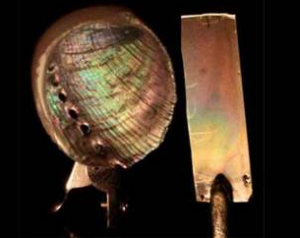 For the first time, scientists have created a material that mimics mother-of-pearl in structure, mechanical behavior and optical appearance. Nacre, also called mother of pearl, is the iridescent coating that is found on the inside of some molluscs and on the outer coating of pearls.
For the first time, scientists have created a material that mimics mother-of-pearl in structure, mechanical behavior and optical appearance. Nacre, also called mother of pearl, is the iridescent coating that is found on the inside of some molluscs and on the outer coating of pearls.
The research, from scientists at Cambridge University, was published this week in Nature Communications.
Nacre, as pearl and bead stringers know, is the crystalline substance that makes a pearl a pearl. As gemologists, we look for nacre coverage and depth in evaluating the quality of a pearl. Pearls that are yanked from a mollusk too early, as is frequently the case in very inexpensive pearls, are dull and can show an unappealing milky quality.
We also see nacre on the inside shells of mollusks which we refer to as mother-of-pearl. Mother-of-pearl can range from very low quality to beautifully iridescent, multiple colors that appear to float over the surface of the material. Iridescence is an optical phenomenon where wavelengths of light are scattered and refracted back toward the viewer. In freshwater water pearls where it occurs more frequently than saltwater pearls, It is a prized phenomenon. It occurs because (often) there is no bead that simulates the growth of nacre.
The Cambridge researchers say the new material is environmentally friendly, but tougher than mother-of-pearl. Although the research appears aimed at “coating materials” for engineering applications, it’s reasonable to assume that an entrepreneurial jewelry company will soon be producing simulated mother-of-pearl. I’ve no doubt that the GIA (Gemological Institute of America) and other gemological educational organizations are following these developments carefully.

